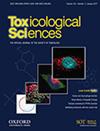野生型和 PPARα 基因敲除小鼠肝细胞中 HFPO-DA 与原型 PPARα、PPARγ 和细胞毒性药物的转录组特征比较
IF 3.4
3区 医学
Q2 TOXICOLOGY
引用次数: 0
摘要
最近对短链多氟烷基物质(PFAS)HFPO-DA(2,3,3,3-四氟-2-(七氟丙氧基)丙酸铵)进行了体外转录组分析、支持从体内数据得出的结论,即 HFPO-DA 介导的对小鼠肝脏的影响是过氧化物酶体增殖激活受体α(PPARα)激活剂诱导啮齿动物肝癌发生作用模式(MOA)早期关键事件的一部分。经 HFPO-DA 处理的啮齿类动物肝细胞的转录组反应与经 PPARα 激动剂处理的肝细胞高度一致,而与经 PPARγ 激动剂或细胞毒药物处理的肝细胞缺乏一致性。为了弄清 HFPO-DA 介导的小鼠肝脏转录组反应是否依赖于 PPARα,我们对原代 PPARα 基因敲除(KO)和野生型(WT)小鼠肝细胞样本进行了额外的转录组分析,这些样本分别暴露于不同浓度的 HFPO-DA、PPARα 的成熟激动剂(GW7647)和 PPARγ 激动剂(罗格列酮)或细胞毒性药物(对乙酰氨基酚或 d-半乳糖胺)12、24 或 72 小时。在 WT 肝细胞中,HFPO-DA 和 GW7647 的通路和预测的上游调节因子水平反应高度一致。在 PPARα KO 肝细胞中也观察到了类似的模式,尽管有一个明显的时间和浓度依赖性延迟,可能是由代偿反应介导的。在暴露于罗格列酮、对乙酰氨基酚和 d-半乳糖胺的 PPARα KO 肝细胞中没有观察到这种延迟。HFPO-DA 和 GW7647 在有 PPARα 存在和没有 PPARα 存在的体外情况下的转录组信号相似,这表明这两种化合物具有共同的 MOA。本文章由计算机程序翻译,如有差异,请以英文原文为准。
Comparison of transcriptomic profiles between HFPO-DA and prototypical PPARα, PPARγ, and cytotoxic agents in wild-type and PPARα knockout mouse hepatocytes
Recent in vitro transcriptomic analyses for the short-chain polyfluoroalkyl substance (PFAS), HFPO-DA (ammonium, 2,3,3,3-tetrafluoro-2-(heptafluoropropoxy)-propanoate), support conclusions from in vivo data that HFPO-DA-mediated liver effects in mice are part of the early key events of the peroxisome proliferator-activated receptor alpha (PPARα) activator-induced rodent hepatocarcinogenesis mode of action (MOA). Transcriptomic responses in HFPO-DA-treated rodent hepatocytes have high concordance with those treated with a PPARα agonist and lack concordance with those treated with PPARγ agonists or cytotoxic agents. To elucidate whether HFPO-DA-mediated transcriptomic responses in mouse liver are PPARα-dependent, additional transcriptomic analyses were conducted on samples from primary PPARα knockout (KO) and wild-type (WT) mouse hepatocytes exposed for 12, 24 or 72 hours with various concentrations of HFPO-DA, or well-established agonists of PPARα (GW7647) and PPARγ (rosiglitazone), or cytotoxic agents (acetaminophen or d-galactosamine). Pathway and predicted upstream regulator-level responses were highly concordant between HFPO-DA and GW7647 in WT hepatocytes. A similar pattern was observed in PPARα KO hepatocytes, albeit with a distinct temporal and concentration-dependent delay potentially mediated by compensatory responses. This delay was not observed in PPARα KO hepatocytes exposed to rosiglitazone, acetaminophen, d-galactosamine. The similarity in transcriptomic signaling between HFPO-DA and GW7647 in both the presence and absence of PPARα in vitro indicates these compounds share a common MOA.
求助全文
通过发布文献求助,成功后即可免费获取论文全文。
去求助
来源期刊

Toxicological Sciences
医学-毒理学
CiteScore
7.70
自引率
7.90%
发文量
118
审稿时长
1.5 months
期刊介绍:
The mission of Toxicological Sciences, the official journal of the Society of Toxicology, is to publish a broad spectrum of impactful research in the field of toxicology.
The primary focus of Toxicological Sciences is on original research articles. The journal also provides expert insight via contemporary and systematic reviews, as well as forum articles and editorial content that addresses important topics in the field.
The scope of Toxicological Sciences is focused on a broad spectrum of impactful toxicological research that will advance the multidisciplinary field of toxicology ranging from basic research to model development and application, and decision making. Submissions will include diverse technologies and approaches including, but not limited to: bioinformatics and computational biology, biochemistry, exposure science, histopathology, mass spectrometry, molecular biology, population-based sciences, tissue and cell-based systems, and whole-animal studies. Integrative approaches that combine realistic exposure scenarios with impactful analyses that move the field forward are encouraged.
 求助内容:
求助内容: 应助结果提醒方式:
应助结果提醒方式:


